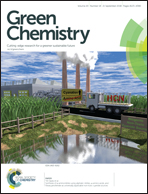Integrated diesel production from lignocellulosic sugars via oleaginous yeast†
Abstract
Oleaginous microbes are promising platform strains for the production of renewable diesel and fatty-acid derived chemicals given their innate capacity to produce high lipid yields from lignocellulose-derived sugars. Substantial efforts have been conducted to engineer model oleaginous yeasts primarily on model feedstocks, but to enable lipid production from biomass, judicious strain selection based on phenotypes beneficial for processing, performance on realistic feedstocks, and process integration aspects from sugars to fuels should be examined holistically. To that end, here we report the bench-scale production of diesel blendstock using a biological-catalytic hybrid process based on oleaginous yeast. This work includes flask screening of 31 oleaginous yeast strains, evaluated based on baseline lipid profiles and sugar consumption with corn stover hydrolysate. Three strains were down-selected for bioreactor performance evaluation. The cultivation results reveal that Cryptococcus curvatus ATCC 20509 and Rhodosporodium toruloides DSM-4444 exhibit equivalent fatty acid methyl ester (FAME) yield (0.24 g g−1), whereas the highest overall FAME productivity (0.22 g L−1 h−1) was obtained with C. curvatus, and R. toruloides displayed the highest final FAME titer (23.3 g L−1). Time-resolved lipid profiling (including neutral and polar lipid classing) demonstrated triacylglycerol accumulation as the predominant lipid class in all strains. When evaluating tolerance mechanisms to inhibitory compounds, all strains could reduce and oxidize 5-(hydroxymethyl)furfural, illustrating parallel detoxification mechanisms. The R. toruloides strain was also capable of growth on four aromatic compounds as a sole carbon source, suggesting its use as a strain for simultaneous sugar and lignin conversion. Lipids from R. toruloides were recovered using a mild acid treatment and extraction, hydrogenated, and isomerized to produce a renewable diesel blendstock. The blendstock exhibited a cloud point of −14.5 °C and simulated distillation showed that approximately 75% of the product was in the diesel range with a T90 consistent with no. 2 diesel fuel. Taken together, these results demonstrate an integrated process for renewable diesel production, identify oleaginous strains for further development, and highlight opportunities for improvements to an oleaginous microbial platform for the production of renewable diesel blendstock.



 Please wait while we load your content...
Please wait while we load your content...